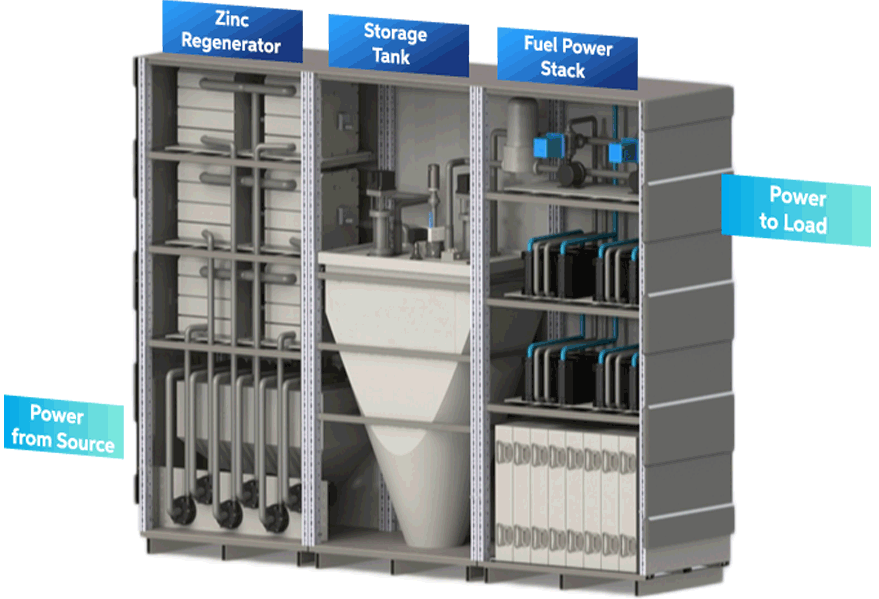
In Western Canada and around the world, the energy sector is rapidly transforming to one that promises to be cleaner, greener and more efficient. Each month, the Canada West Foundation’s Energy Innovation Brief brings you stories about technology innovations happening across the industry – in oil and gas, renewables, energy storage and transmission. If you have an idea for a story, email us at:
In this month’s roundup of energy innovation news:
1. Electrifying the sky: zero-emission aircraft reaches new milestone
2. Attention, GHG emitters: new ‘eye-in-the-sky’ will be tracking your emissions
3. Exporting solar energy from Australia to Singapore via subsea cables
4. New technology could download energy from Wi-Fi signals
5. Seattle tech giants are funding climate tech now
6. Made in Canada: new zinc-air battery shows promising potential for energy storage
Electrifying the sky: zero-emission aircraft reaches new milestone
The future of air travel is looking electric as zero-emission aircraft reach new heights. In May 2020, the world’s largest zero-emission aircraft, the Cessna 208B Grand Caravan, successfully completed its maiden flight in Washington State in the U.S., without using a drop of fuel. Developed by U.S.-based magniX, the electric aircraft is powered by a 750-horsepower electric motor, has a distance capacity of 160 kilometers, and can seat up to nine passengers. In fact, it is the second electric aircraft to be developed by magniX. The company’s first six-seater commercial model, the de Havilland Beaver, completed its first successful flight in 2019 – making it the world’s first electric aircraft to take flight. Currently, the Beaver is operated by Harbour Air, in Vancouver, which in 2019 announced a partnership with magniX to develop the world’s first completely electric commercial seaplane fleet. MagniX expects that its latest and largest electric aircraft will be ready to enter into commercial service by the end of 2021. Read the full story here.
Emissions from the global airline industry are rising steadily each year as more people are flying (well, maybe not in 2020, but in general). Yet, for the airline industry, finding viable ways to reduce its carbon footprint is not an easy task. Electric airplanes are a promising solution, but have inherent limits as they can’t travel nearly as far or carry as much weight as fuel-propelled airplanes. As airlines look to evolve their business models to adapt to a lower-carbon future, it will be interesting to see what the future of electric air travel holds.
Attention, GHG emitters: new ‘eye-in-the-sky’ will be tracking your emissions
The latest technological innovation to track global GHG emissions is out of this world – literally. Montreal-based company GHGSat Inc. is set to launch its latest innovation, a microwave-sized satellite named Iris, into space to monitor and collect data on global GHG emissions. Iris has been in the making for three years and has built upon lessons learned from the company’s first GHG-monitoring satellite, Claire, which was released into orbit in 2016. For instance, Iris’ high-resolution imagery will now be able to detect small emissions sites with pinpoint accuracy, such as methane emissions from oil and gas wells, pipelines, power plants, farms, and factories. It will also be equipped with an enhanced spectrometer to quantify emissions by site and will cover the earth’s surface every two weeks. Iris was expected to launch in late June 2020 but incurred delays due to COVID-19. Over the next few years, the company plans to have up to 10 satellites like Iris in operation to increase the frequency and accuracy of GHG emissions data. Read the full story here.
Detecting small methane leakages is neither easy nor cheap, as methane is invisible and odorless. Detection usually involves inspectors walking around with infrared cameras, or installing sensors on natural gas storage tanks or pipelines. Satellite detection avoids these problems; and may also provide more accurate emissions accounting than traditional engineering-based estimating approach. For instance, using aerial measurements, a 2018 study by the Environmental Defense Fund and several U.S. universities found that methane leaks in the U.S. oil and gas industry were 60% higher than what was reported by the U.S. Environmental Protection Agency. GHG-monitoring satellites such as Iris could benefit global efforts to track and crack down on methane emissions by identifying large and small leaks across the globe.
Exporting solar energy from Australia to Singapore via subsea cables
For the first time in history, the market for solar power is stretching its boundaries. Over in Australia, the Sun Cable Project is in the works to bring Singapore a brighter future (literally) by exporting solar energy across the Pacific Ocean. The $20 billion project will involve the construction of a high voltage direct current (HVDC) cable spanning 3,800 kilometers across the seafloor, and is expected to supply 10 terawatt-hours of solar energy each year —about 20% of Singapore’s annual energy needs. The Sun Cable Project is expected to reach commercialization in Singapore by 2027, with plans to undertake a new export route to Indonesia in its next phase. And according to Sun Cable CEO David Griffin, if all goes well, this mega-project will not be the last — and we could see more major cities powered by long-distance sunlight in the future. Read the full story here.
If this project is successful, this technology could be the key to balancing tricky supply and demand problems for solar. It would enable countries that currently struggle to access a stable supply of solar energy (due to a lack of land availability and/or consistent sun exposure) to procure greater amounts of renewable energy. And it could also allow countries with abundant solar energy resources, including Canada, to participate in a new market for exported solar energy. In 2018, Canada had the ninth largest solar photovoltaic capacity in the world and is currently constructing one of the world’s largest solar farms in southern Alberta. Just as Canada exports its world-class fossil fuels to countries in need around the world, projects like these make it likely that we could one day be exporting another abundant natural resource – sunshine – as well.
New technology could download energy from Wi-fi signals
We rely on having a Wi-fi connection for so many aspects of our daily routine – from catching up on the news, checking the weather, or replying to emails from virtually anywhere. But what if it could also provide a source of energy? A team of physicists at MIT have discovered a way to use the terahertz waves (T-rays) found in ambient Wi-Fi signals as a way to power small devices, such as a smartphone. By designing an antenna made up of layers of graphene (an atomic form of carbon) and boron nitride (a chemical compound), the team has been able to use the antenna to steer the T-rays, or Wi-Fi signal, into a direct electrical current. Theoretically, anyone with a smartphone in range of a Wi-Fi signal could attach the antenna to their device and wirelessly charge it. Yet, so far this technology has only been proven at subfreezing temperatures. The team of physicists are now working to develop a similar device that could work at normal temperatures, and to also expand the device’s application from charging personal electronics such as smartphones and watches to wirelessly powering implants in medical patient’s bodies (i.e. pacemakers). Read the full story here.
T-rays are all around us, whether we tap into them or not. Until now, they have been an entirely unused (and unknown) source of energy. If the antenna is successful at normal temperatures, it could utilize this ‘wasted’ energy from Wi-Fi signals to power small devices in our homes and businesses, and could make a dent in energy consumption.
Seattle tech giants are funding climate tech now
The West Coast’s tech titans are taking the plunge to battle climate change. As technology continues to embed itself into our daily lives, more tech companies have committed to reducing emissions and taking accountability for their carbon footprints. Companies such as Google, Amazon, Microsoft and Facebook have either already achieved carbon neutrality for their own operations or have made promises to achieve it shortly.
But now, some companies are stepping up to go further, and are using their ample wealth to make what they hope will be a meaningful difference across a broad range of industries including transportation, agriculture, manufacturing and energy generation. In early 2020, Microsoft announced that it will invest $1 billion in its “Climate Innovation Fund” over the next four years. The money will primarily used innovative technologies that have already been developed and proven, but need capital to scale in the market. They plan to focus on areas such as direct carbon removal, digital optimization, advanced energy systems, industrial materials, circular economy, water technologies and sustainable agriculture. And crucially, they will prioritize projects that ensure and undeserved communities will benefit from the climate solution. Similarly, Amazon also recently pledged $2 billion for a “Climate Change Fund” to be put towards “the development of sustainable and decarbonizing technologies and services” across similar areas. This fund will help Amazon work on its own substantial emissions problem (the company’s annual GHG emissions are equivalent to about 85% of Switzerland’s or Denmark’s annual emissions, but if invested well could make a meaningful difference in a global problem. Read the full story here.
Made in Canada: new zinc-air battery shows promising potential for energy storage
A new Canadian-made battery is gearing up to disrupt the market for energy storage. Zinc8 Energy Solutions, based in Vancouver, has developed a new regenerative battery technology made out of zinc and air that has already shown to be more cost-effective and longer lasting than lithium ion batteries. Here’s how it works: the Zinc8 battery uses electricity from the grid to split a chemical called zincate (ZnOH4) into charged zinc particles, water, and oxygen. Then, the zinc particles are stored in a potassium hydroxide electrolyte – where they can be kept for months without degrading. When electricity is needed, the charged zinc particles are recombined with the oxygen and water to release the stored electricity and produce zincate, which is then cycled back to begin the process again. Instead of requiring multiple batteries to store energy for longer periods of time (such as lithium-ion batteries), the zinc-air battery can be easily scaled by increasing the size of the storage tank and amount of electrolyte. As the storage capacity increases, the overall cost decreases. For instance, the capital cost of a zinc-air battery falls from $250/kWh for an eight-hour storage period to $100/kWh for 32 hours, while lithium-ion batteries cost about $300/kWh for any duration over eight hours. After winning the New York Power Authority’s (NYPA) Innovation Challenge in January, Zinc8 is currently working on three pilot projects: a 100kW/1MWh for the NYPA in western New York state; a 100kW/1.5MWh project in Brooklyn, NY; and a 40kW project in Surrey, B.C. Read the full story here and more about zinc-air battery history and technology here.

The Zinc8 zinc-air hybrid flow battery system. Photo: Zinc8
The concept of a zinc battery is nothing new. In fact, it has been long recognized as an effective form of energy storage due to zinc’s high energy density, abundant availability, and low-cost. The first zinc-air battery was first commercialized in 1932, where it was widely used for small-scale medical and telecommunications purposes, such as hearing aids and pagers. Yet, for decades, the zinc-air battery’s potential for large-scale energy storage was largely hindered by a fundamental flaw – the formation of a coating on the zinc electrode (called a dendrite) that caused problems such as short-circuits. Zinc8 was able to innovate a process that prevented this from happening. Now, the zinc-air battery is re-emerging to compete with other battery systems, such as lithium-ion, in the market for large-scale energy storage.
The Energy Innovation Brief is compiled by Jade McLean and Marla Orenstein, with this month’s edition featuring contributions by research interns Taylor Sterzuk and Taylor Blaisdell. If you like what you see, subscribe to our mailing list and share with a friend. If you have any interesting stories for future editions, please send them to .
Banner photo by Jonah Pettrich, Unsplash
